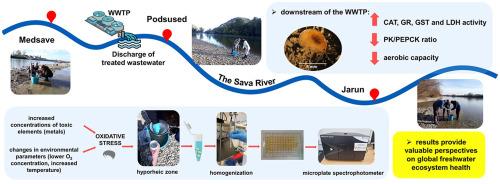Oxidative stress and metabolic adaptation in Synurella ambulans: Assessing pollution impact in the hyporheic zone
IF 7.3
2区 环境科学与生态学
Q1 ENVIRONMENTAL SCIENCES
引用次数: 0
Abstract
Oxidative stress is a prevalent mechanism of physiological stress caused by exposure to pollutants or environmental hypoxia in aquatic organisms. The hyporheic zone (HZ), a transitional area between surface and groundwater with distinct ecological conditions, is highly susceptible to pollution and hypoxia, but the physiological responses of its aquatic inhabitants to these stressors remain poorly understood. The aim of this study was to investigate the effect of wastewater treatment plant (WWTP) effluent as a point source of contamination on the battery of biomarkers of antioxidant defence (catalase, CAT; glutathione reductase, GR), xenobiotic biotransformation (glutathione-S-transferase, GST), and aerobic/anaerobic energy metabolism (pyruvate kinase, PK; phosphoenolpyruvate carboxykinase, PEPCK; lactate dehydrogenase, LDH) in a stygophilous freshwater amphipod Synurella ambulans from the Sava River HZ. The samplings were conducted in relation to the Sava River’s hydrologic regime after low river discharge (in September 2020) and after high river discharge (in April 2021) at one site (Medsave) upstream of the WWTP outflow and at two sites downstream (Podsused and Jarun). S. ambulans populations at sites downstream of the WWTP showed higher CAT, GR, GST and LDH activity than population at the upstream site. PK/PEPCK ratio was significantly lower in the S. ambulans populations at Podsused and Jarun sites compared to Medsave population after low river discharge, indicating lower aerobic capacity and greater reliance on anaerobic metabolic pathways. This study improves the understanding of the physiological responses of crustaceans exposed to chemical pollution and environmental stressors, thus contributing to the ecological assessment of groundwater connected ecosystems.

驴索拉的氧化应激和代谢适应:评估污染对下潜区的影响
氧化应激是水生生物暴露于污染物或环境缺氧引起的一种普遍的生理应激机制。低渗带(HZ)是地表水和地下水之间的过渡区域,具有独特的生态条件,极易受到污染和缺氧的影响,但其水生生物对这些压力的生理反应尚不清楚。本研究的目的是研究污水处理厂(WWTP)废水作为污染的点源对抗氧化防御生物标志物(过氧化氢酶,CAT,谷胱甘肽还原酶,GR),外源生物转化(谷胱甘肽- s -转移酶,GST)和好氧/厌氧能量代谢(丙酮酸激酶,PK,磷酸烯醇丙酮酸羧激酶,PEPCK, pck, pck, pck)的影响。来自萨瓦河(HZ)的一种嗜茎的淡水片足类水足动物的乳酸脱氢酶(LDH)。在污水处理厂出水口上游的一个地点(Medsave)和下游的两个地点(Podsused和Jarun),对低流量(2020年9月)和高流量(2021年4月)后萨瓦河的水文状况进行了采样。污水处理厂下游地区的水虻种群的CAT、GR、GST和LDH活性均高于上游地区。Podsused和Jarun站点的S. ambulans种群的PK/PEPCK比在低河水流量后显著低于Medsave种群,表明其有氧能力较低,更依赖于厌氧代谢途径。本研究提高了甲壳类动物对化学污染和环境胁迫的生理反应的认识,有助于地下水连接生态系统的生态评价。
本文章由计算机程序翻译,如有差异,请以英文原文为准。
求助全文
约1分钟内获得全文
求助全文
来源期刊

Environmental Pollution
环境科学-环境科学
CiteScore
16.00
自引率
6.70%
发文量
2082
审稿时长
2.9 months
期刊介绍:
Environmental Pollution is an international peer-reviewed journal that publishes high-quality research papers and review articles covering all aspects of environmental pollution and its impacts on ecosystems and human health.
Subject areas include, but are not limited to:
• Sources and occurrences of pollutants that are clearly defined and measured in environmental compartments, food and food-related items, and human bodies;
• Interlinks between contaminant exposure and biological, ecological, and human health effects, including those of climate change;
• Contaminants of emerging concerns (including but not limited to antibiotic resistant microorganisms or genes, microplastics/nanoplastics, electronic wastes, light, and noise) and/or their biological, ecological, or human health effects;
• Laboratory and field studies on the remediation/mitigation of environmental pollution via new techniques and with clear links to biological, ecological, or human health effects;
• Modeling of pollution processes, patterns, or trends that is of clear environmental and/or human health interest;
• New techniques that measure and examine environmental occurrences, transport, behavior, and effects of pollutants within the environment or the laboratory, provided that they can be clearly used to address problems within regional or global environmental compartments.
 求助内容:
求助内容: 应助结果提醒方式:
应助结果提醒方式:


